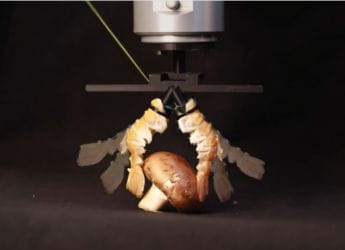- Home
- Science
- Science News
- MIT Develops Low Resource AI System to Control Soft Robots with Just One Image
MIT Develops Low-Resource AI System to Control Soft Robots with Just One Image
MIT developed a deep learning system that lets soft robots follow commands from a single image, enabling accurate, low-cost control in tight and rough spaces.

Photo Credit: Nature (2025)
Conventional robots are easier to control and model for industrial and hazardous tasks
The use of conventional robots for industry and hazardous environments is easy for the purpose of control and modelling. However, these are too rigid to operate in confined places and uneven terrain. The soft bio-related roots are better adapted to the environment and manoeuvring in inaccessible places. Such flexible capabilities would need an array of on-board sensors and spacious models which are tailored to each robot design. Having a new and less resource-demanding approach, the researchers at MIT have developed a far less complex, deep learning control system that teaches the soft, bio-inspired robots to follow the command from a single image only.
Soft Robots Learn from a Single Image
As per Phys.org, this research has been published in the journal Nature, by training a deep neural network on two to three hours of multi-view images of various robots executing random commands, the scientists trained the network to reconstruct the range and shape of mobility from only one image. The previous machine learning control designs need customised and costly motion systems. Lack of a general-purpose control system limited the applications and made prototyping less practical.
The methods unshackle the robotics hardware design from the ability to model it manually. This has dictated precision manufacturing, extensive sensing capabilities, costly materials and reliance on conventional and rigid building blocks.
AI Cuts Costly Sensors and Complex Models
The single camera machine learning approach allows the high-precision control in tests on a variety of robotic systems, adding the 3D-printed pneumatic hand, 16-DOF Allegro hand, a soft auxetic wrist and a low-cost Poppy robot arm.
As this system depends on the vision alone, it might not be suitable for more nimble tasks which need contact sensing and tactile dynamics. The performance may also degrade in cases where visual cues are not enough.
Researchers suggest the addition of sensors and tactile materials that can enable the robots to perform different and complex tasks. There is also potential to automate the control of a wider range of robots, together with minimal or no embedded sensors.
Get your daily dose of tech news, reviews, and insights, in under 80 characters on Gadgets 360 Turbo. Connect with fellow tech lovers on our Forum. Follow us on X, Facebook, WhatsApp, Threads and Google News for instant updates. Catch all the action on our YouTube channel.
Related Stories
- Samsung Galaxy Unpacked 2025
- ChatGPT
- Redmi Note 14 Pro+
- iPhone 16
- Apple Vision Pro
- Oneplus 12
- OnePlus Nord CE 3 Lite 5G
- iPhone 13
- Xiaomi 14 Pro
- Oppo Find N3
- Tecno Spark Go (2023)
- Realme V30
- Best Phones Under 25000
- Samsung Galaxy S24 Series
- Cryptocurrency
- iQoo 12
- Samsung Galaxy S24 Ultra
- Giottus
- Samsung Galaxy Z Flip 5
- Apple 'Scary Fast'
- Housefull 5
- GoPro Hero 12 Black Review
- Invincible Season 2
- JioGlass
- HD Ready TV
- Laptop Under 50000
- Smartwatch Under 10000
- Latest Mobile Phones
- Compare Phones
- Realme P4x 5G
- OnePlus Ace 6T
- Nubia Flip 3
- Nubia Fold
- OPPO A6x 5G
- Samsung Galaxy Z TriFold
- Poco F8 Ultra
- Poco F8 Pro
- Asus ProArt P16
- MacBook Pro 14-inch (M5, 2025)
- Poco Pad M1
- Poco Pad X1
- Just Corseca Skywatch Pro
- Honor Watch X5
- Acerpure Nitro Z Series 100-inch QLED TV
- Samsung 43 Inch LED Ultra HD (4K) Smart TV (UA43UE81AFULXL)
- Asus ROG Ally
- Nintendo Switch Lite
- Haier 1.6 Ton 5 Star Inverter Split AC (HSU19G-MZAID5BN-INV)
- Haier 1.6 Ton 5 Star Inverter Split AC (HSU19G-MZAIM5BN-INV)

















